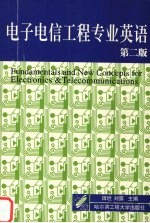图书介绍
电子电信工程专业英语 第2版PDF|Epub|txt|kindle电子书版本网盘下载

- 田坦,刘露主编 著
- 出版社: 哈尔滨:哈尔滨工程大学出版社
- ISBN:7810736167
- 出版时间:2004
- 标注页数:374页
- 文件大小:95MB
- 文件页数:384页
- 主题词:电子技术(学科: 英语) 电信(学科: 英语) 电子技术 英语 电信
PDF下载
下载说明
电子电信工程专业英语 第2版PDF格式电子书版下载
下载的文件为RAR压缩包。需要使用解压软件进行解压得到PDF格式图书。建议使用BT下载工具Free Download Manager进行下载,简称FDM(免费,没有广告,支持多平台)。本站资源全部打包为BT种子。所以需要使用专业的BT下载软件进行下载。如BitComet qBittorrent uTorrent等BT下载工具。迅雷目前由于本站不是热门资源。不推荐使用!后期资源热门了。安装了迅雷也可以迅雷进行下载!
(文件页数 要大于 标注页数,上中下等多册电子书除外)
注意:本站所有压缩包均有解压码: 点击下载压缩包解压工具
图书目录
Part Ⅰ1
Lesson 1 Periodic Signkals1
1.1 Time-Domain Descriptions1
1.2 Frequency-Domain Descriptions3
1.3 Orthogonal Functions4
1.4 The Fourier Series7
词汇11
Lesson 2 Aperiodic Signals14
2.1 Introduction14
2.2 The Exponential Form of the Fourier Series14
2.3 The Fourier Transform16
2.4 The Laplace Transform26
词汇31
Lesson 3 Sampled-Data Signals33
3.1 Introduction33
3.2 Mathematical Description Using the Dirac Function33
3.3 Spectra of Sampled-Data Signals36
3.4 The z-Transform39
3.5 Discussion47
词汇49
Lesson 4 Random Signals50
4.1 Introduction50
4.2 Elements of Probability Theory53
4.3 Amplitude Distributions and Moments59
4.4 The Autocorrelation and Power Spectral Density Functions62
4.5 Important Types of Random Signal69
词汇87
Lesson 5 Signals and Systems89
5.1 Introduction89
5.2 Basic Aspects of Linear Processing90
5.3 Convolution,Correlation and Filtering102
5.4 The Processing of Random Signals105
5.5 Nonlinear Processing111
词汇113
Lesson 6 Modulation and Sampling116
6.1 Introduction to Modulation116
6.2 Signal Sampling and Reconstitution118
6.3 Other Modulation Processes125
词汇133
Lesson 7 Filters135
7.1 Introduction135
7.2 General Aspects of Filter Performance136
7.3 Analogue Filters140
7.4 Digital Filters143
词汇151
Part Ⅱ152
Lesson 8 Underwater Acoustic Signal Processing152
8.1 Quantitative Description of Signal152
8.2 Qualitative Description of the Sources of Noise155
8.3 Comparison of Sonar,Radar,and Seismic Parameters157
8.4 Target Strength and the Sonar Range Equation161
8.5 Reflection and Scattering from Boundaries163
8.6 Effects of an Inhomogeneous Medium165
8.7 Criteria for Measuring the Success of Detection166
8.8 Directional Arrays168
词汇169
Lesson 9 Underwater Acoustic Imaging173
9.1 Introduction173
9.2 Properties of Underwater Acoustic Imaging Systems174
9.3 Targets and Environmental Requirements176
9.4 Underwater Acoustic Imaging System Concepts178
9.5 Examples of Various Acoustic Imaging Techniques and Systems182
9.6 Summary190
词汇191
Lesson 10 Computer Technology194
10.1 History of Computing194
10.2 Organization of a Stored Program Digital Computer198
词汇208
Lesson 11 Images and Graphics211
11.1 Basic Concepts of Images and Graphics211
11.2 Computer Image Processing217
词汇231
Lesson 12 Communication Technology233
12.1 Basic Knowledge of Communication233
12.2 Introduction to Optical Fiber Communication239
12.3 Satellite Communication244
12.4 Data Communication and Mobile Communication247
词汇253
Lesson 13 Communication Networks257
13.1 Principle for Communication Network257
13.2 ISDN261
13.3 ATM Networks269
13.4 Information Network System273
词汇278
Part Ⅲ281
Lesson 14 The Software Radio Architecture281
14.1 Introduction281
14.2 Software Radio Overview286
14.3 Partitioning of the Channel Processing Stream290
14.4 Estimating Resource Requirements297
14.5 Heterogeneous Muhiprocessing Hardware302
14.6 Open Architecture Software Tools Remain Problematic304
14.7 Conclusions305
词汇307
Lesson 15 Smart Antenna Systems308
15.1 Introduction308
15.2 A Useful Analogy for Adaptive Smart Antennas308
15.3 Antennas and Antenna Systems309
15.4 What Is a Smart Antenna System?315
15.5 The Goals of a Smart Antenna System318
15.6 Signal Propagation:Multipath and Cochannel Interference319
15.7 The Architecture of Smart Antenna Systems324
15.8 Who Can Use Smart Antenna Technology?330
词汇331
Lesson 16 Bluetooth:Technology for Short-Range Wireless Approches333
16.1 Introduction333
16.2 Bluetooth Specifications334
16.3 Radio Front End337
16.4 Piconets and Scatternets339
16.5 Piconet Channel343
16.6 Putting the Pieces Together349
16.7 Conclusion350
词汇351
Lesson 17 Next-Generation Wireless Communications Concepts and Technologies353
17.1 Introduction353
17.2 Ubiquitous Services and Paradigm Change356
17.3 Smart Specturm and Dynamic Spectrum Assignment359
17.4 Smart Resources:a Technological Vision360
17.5 Adaptation363
17.6 Software Radio and Smart Radio368
17.7 Advanced Adaptive Waveforms and Physical Layer370
17.8 Qos,Adaptive Networks,and Universal Access Nodes372
17.9 Conclusion373
词汇374